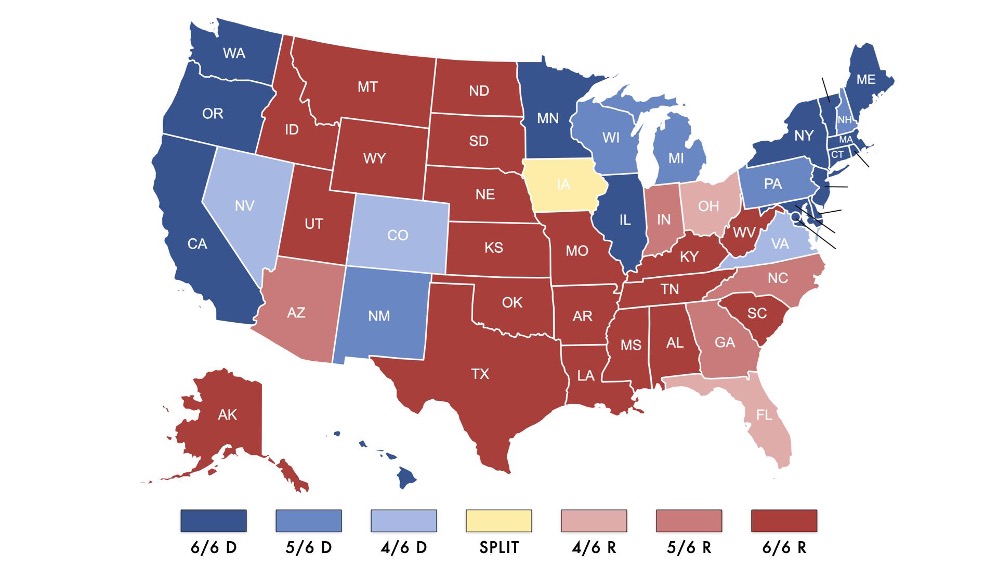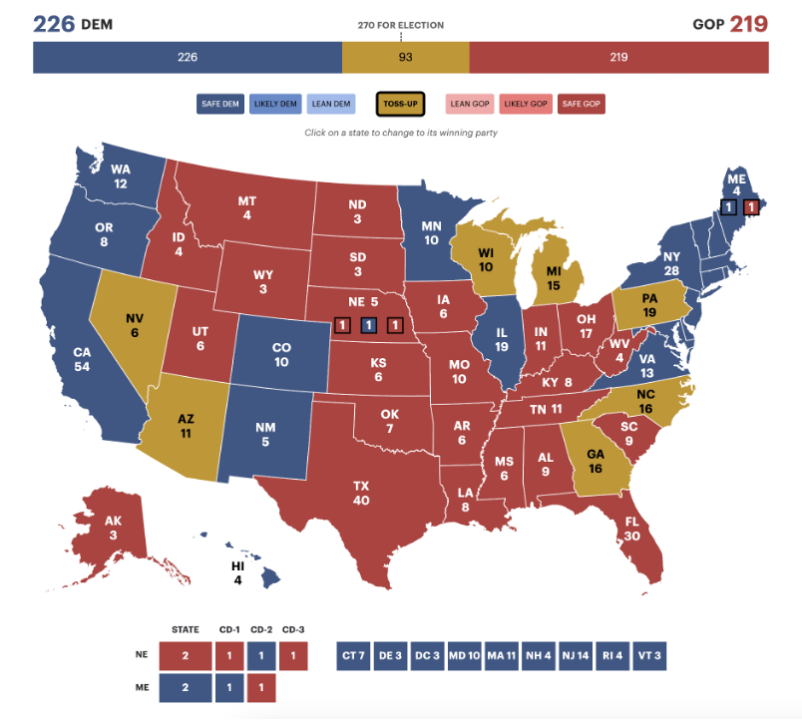What the shrinking Electoral College battleground means for 2024

America is in the midst of a unique electoral era marked by nine consecutive presidential elections — 1988 to 2020 — where neither the Democratic nor Republican candidate has secured a double-digit victory margin in the popular vote. This ongoing streak is the longest in the history of the current two-party system.
This trend has important consequences for the Electoral College: 40 out of 50 states have repeatedly voted for either the Democratic or Republican nominee in each of the last four elections — a level of consistency not seen since the early 20th century.

The map above displays how every state has voted in the six presidential elections since 2000, a period when each major party won the presidency three times (GOP in 2000, 2004 and 2016; Democrats in 2008, 2012 and 2020). All but six states — Colorado, Florida, Iowa, Nevada, Ohio and Virginia — have voted for the same party in at least five of those six contests.
Notably, Barack Obama’s victory in 2008 is the only time during this stretch when a candidate received at least 350 electoral votes, making the 44th president the only contender to receive at least two-thirds of the electoral vote since 2000. Prior to this period, landslide victories were much more common: between 1920 and 1996, 17 of the 22 presidential election winners received more than 350 electoral votes, including 14 occasions when the victor won over 400 votes.
This fall, the likely rematch between Joe Biden and Donald Trump is expected to extend the streak of single-digit popular vote margins. Decision Desk HQ/The Hill’s latest national average has Trump leading Biden by 1.6 percent, and neither candidate has led the other by more than four points since we began tracking polls in January 2023. The Electoral College battleground map will likely be narrowed down to a historically small number of truly competitive states.
As the Electoral College battleground shrinks, the calculus that optimizes for 270 electoral votes changes. Attention is increasingly focused on seven key states: Arizona, Georgia, Michigan, Nevada, North Carolina, Pennsylvania and Wisconsin. All seven were decided by less than 3 percent in the 2020 election; Arizona, Georgia, Michigan, Pennsylvania and Wisconsin backed Trump in 2016, then swung to Biden in 2020.
With these seven states categorized as toss-ups, the current electoral college projection shows Biden leading with 226 solid electoral votes compared to Trump’s 219, with 93 votes up for grabs — a remarkably slim margin.

If Trump wins the seven key battlegrounds — which current polling data from Decision Desk HQ says he is favored to (except for in Pennsylvania, where data is pending) — he would reach 312 electoral votes. Conversely, if Biden were to hold these states and flip North Carolina, then he would hit 319 electoral votes.
The next most flippable states for Biden are Florida (R+3.4 in 2020) and Texas (R+5.6). Either would likely be a substantial lift for the president. Texas hasn’t voted for a Democrat in a statewide election since 1990. Florida is one of only eight states where Trump improved his margin from 2016 to 2020, and the state is rapidly trending to the right, with Gov. Ron DeSantis and Sen. Marco Rubio cruising to double-digit reelection wins in 2022. Biden’s apparent weakness with Hispanic voters is likely to provide an additional obstacle in both states.
The gap between the closest state won by each candidate is an interesting data point. In 2020, this gap was 1.59 percent, with Georgia (D+0.24) being the closest state Biden won and North Carolina (R+1.35) the closest for Trump. This margin is in line with historical trends. For instance, in 2016, the gap was a mere 0.53 percent between Hillary Clinton’s narrow win in New Hampshire and Trump’s in Michigan. Going back to 1976, the average difference between the closest Democratic and Republican states has been around 1.61 percent, with the largest gap being 3.67 percent.
Looking ahead to 2024, this gap could reach its highest mark in decades. If Trump wins the seven key battlegrounds, the state likely to represent Biden’s closest win could be Minnesota, New Hampshire, Maine, Virginia or New Mexico. Biden won each of these states by a margin of at least seven points in 2020, providing a substantial cushion, and while Trump is exceeding expectations in polls surveyed across the country, he has yet to lead in a single poll taken in any one of those five states. Moreover, according to Metaculus’s prediction markets, Trump’s chances of winning any of these states are currently below 10 percent.
It’s worth stating, again, how historically unusual this is. The map has never been this narrow, and as such it’s hard to say with much certainty what the effects will be in November. It’s possible that pundits are missing clues that the map is about to change. In every single election where the White House has changed hands, the winning candidate has brought a new state into their party’s column; for Trump in 2024, that would most likely be Nevada.
But expectations matter because they shape campaign strategies. A presidential candidate must make choices about where to hold rallies, run ads and knock on doors through the prism of optimizing for 270 electoral votes — no more, no less. You’re not going to waste time and resources on states where you have no shot.
So while Biden might tell donors that he thinks he can win Florida, you’re more likely to see snowflakes fall in Miami than see the president seriously contest the Sunshine State. And that will have important spillover effects down-ballot — less money being invested at the top of the ticket might hurt fellow Democrats running for Congress or state legislature, and the perception that a state has been written off by one party might depress turnout among their base. In this way, the narrowing of the map can become a self-fulfilling prophecy.
Ryan Gest is a data science and digital content fellow at Decision Desk HQ, and the creator of “Election Predictions Official” on YouTube. Follow him @RyanGestEPO. Milan Singh is a data science fellow at Decision Desk HQ and a sophomore at Yale College. Follow him @milansingh03.
Copyright 2023 Nexstar Media Inc. All rights reserved. This material may not be published, broadcast, rewritten, or redistributed.


